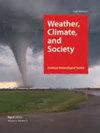气候变化和白令海北部海冰减少对生态和人类的影响
IF 1.9
4区 地球科学
Q3 ENVIRONMENTAL STUDIES
引用次数: 0
摘要
我们的目标是将气候尺度测量与区域物理和生态系统变化以及人类影响联系起来。在2018年和2019年冬季,白令海的海冰覆盖面积达到了创纪录的最低水平,对海洋生态系统和人类活动的影响持续多年。考虑到白令海北部风暴的年增率通常很大,2018年和2019年连续出现的海冰最小值当然是出乎意料的。生态变化表明北部海洋食物网的重组,包括海冰藻类和幼蟹的减少,以及掠食性鳕鱼和鳕鱼向北移动,影响了较低的营养水平。海冰减少和气温升高可能造成的直接影响包括海鸟和与冰有关的海豹的消瘦和死亡率增加,以及有害藻华的增加。这些变化影响到区域粮食安全、人类/野生动物健康、文化活动和海洋野生动物保护。全球变暖通过减弱的大气北极锋引发了这些事件,北极锋促进了海冰减少、气温升高、南风和波浪状喷射流的自我强化循环。由此对白令海北部居民生计造成的影响是商业和非商业获取基本海洋资源以供出售和直接消费。年际变化仍然很重要;2022年和2023年,阿留申低压系统占区域主导地位,海冰接近气候平均值。对未来几十年的预测是,海冰减少的年份将越来越频繁,生态系统将继续转型,影响白令海北部沿海的重要海洋野生动物资源和居民。本文章由计算机程序翻译,如有差异,请以英文原文为准。
Transformative ecological and human impacts from climate change and diminished sea ice in the northern Bering Sea
Abstract Our goal is to tie climate scale mete o rology to regional physics and ecosystem changes, and on to human impacts. There was record minimum sea-ice cover during winter 2018 and 2019 in the Bering Sea, with continuing multi-year impacts on the marine ecosystem and human activities. The back-to-back sea-ice minimums during 2018 and 2019 were certainly unexpected, given the normal large year-to-year variability of storms for the northern Bering Sea. Ecological shifts indicated reorganization of the northern marine food web that included loss of sea-ice algae and young crabs, and predatory cod and pollock moving north impacting lower trophic levels. Possible direct impacts from sea-ice loss and warmer temperatures included increased seabird and ice-associated seal emaciation and mortality, and increased harmful algal blooms. These changes affected regional food security, human/wildlife health, cultural activities, and marine wildlife conservation. Global warming initiated these events through a weakened atmospheric Arctic Front that promotes a self-reinforcing cycle of sea-ice loss, warmer temperatures, southerly winds and a wavy jet stream. Resulting impacts to livelihoods in the northern Bering Sea were commercial and non-commercial subsistence acquisition of essential marine resources for sale and direct consumption. Interannual variability is still important; during 2022 and 2023 the Aleutian Low pressure system was regionally dominant and sea ice was near the climatological average. Projections for the next decades are for an increasing frequency of low sea-ice years and a continuing ecosystem transition impacting essential marine wildlife resources and residents of the coastal northern Bering Sea.
求助全文
通过发布文献求助,成功后即可免费获取论文全文。
去求助
来源期刊

Weather Climate and Society
METEOROLOGY & ATMOSPHERIC SCIENCES-
CiteScore
3.40
自引率
13.60%
发文量
95
审稿时长
>12 weeks
期刊介绍:
Weather, Climate, and Society (WCAS) publishes research that encompasses economics, policy analysis, political science, history, and institutional, social, and behavioral scholarship relating to weather and climate, including climate change. Contributions must include original social science research, evidence-based analysis, and relevance to the interactions of weather and climate with society.
 求助内容:
求助内容: 应助结果提醒方式:
应助结果提醒方式:


